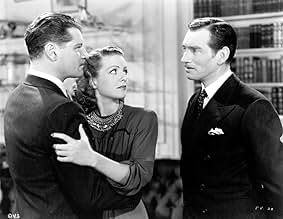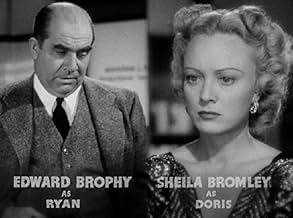Ajouter une intrigue dans votre langueDespite an exclusive contract with the U.S. government, designer Archer Coe's design is being bid on by German, Japanese, and Italian agents - until he's murdered.Despite an exclusive contract with the U.S. government, designer Archer Coe's design is being bid on by German, Japanese, and Italian agents - until he's murdered.Despite an exclusive contract with the U.S. government, designer Archer Coe's design is being bid on by German, Japanese, and Italian agents - until he's murdered.
- Réalisation
- Scénario
- Casting principal
Jimmy Conlin
- Dr. Doremus - Coroner
- (as Jimmy Conlon)
Herbert Anderson
- First Reporter
- (non crédité)
Henry Blair
- Hans Snauble
- (non crédité)
Egon Brecher
- Austrian Judge
- (non crédité)
Avis à la une
This is an adequate afternoon B-feature that probably served more as a warning against fifth-columnists than it actually entertained anyone. It all centres around attempts by the Axis powers to obtain access to the designs of "Archer Coe" (the briefest of appearances from Richard Kipling). Now he has an exclusive arrangement with the Americans so when he is found murdered, it falls to the wily, suspicions and tenacious "Vance" (James Stephenson) to find out who the killers were and on whose malevolent behalf they were working? Did they manage to steal his secret plans? Now this is just a substantial reworking of "The Kennel Murder Case" (1933) - even down to whopping great chunks of the script being transferred, albeit updated, to allow for it's WWII scenario. Although all pretty lightweight and devoid of any real sense of jeopardy, Stephenson is actually quite engaging and there is a decent supporting effort from Edward Trophy ("Ryan") delivering some fun to this rather dry, procedural, crime drama. It's only an hour, and if you like the genre then there isn't really anything not to like - or memorable - about this.
This is a very cheaply made and predictable programmer--predictable since its plot is taken, almost verbatim, from two earlier films. It was literally like splicing two old movie together to make a new film!
The first 15 minutes of the film is lifted right out of PRIVATE DETECTIVE 62 (1933--starring William Powell), though the hero was stealing information from a French safe in the original film and in CALLING PHILO VANCE it involved stealing from an Austrian one. In both, he was working for the state department (though they denied this) and in both cases he was deported back to the US--only to have the boat's captain be told to return the man just as they are pulling into New York harbor--at which point the man jumps overboard and the rest of the film begins. It's so exact that they are practically the same film in the first reel.
Following this narrow escape, the plot is THE KENNEL MURDER CASE (also starring Powell). I am sure of this because I just saw both 1930s films in the last month. In fact, in many places it was word-for-word the same--so much so that I couldn't stand watching the film again--especially because James Stevenson on his best day doesn't even come close to the charm and style of William Powell's version of Philo Vance. It's like having Lee Majors play the lead in High Noon instead of Gary Cooper (this DID happen) or Timothy Dalton play "Rhett Butler" instead of Clark Gable (this, sadly, also DID happen)!! So, unless you've never seen the near-perfect KENNEL MURDER CASE (which earned a well-deserved 9 from me), don't even bother with this by-the-numbers re-make. It just isn't worth your time. And, for that matter, PRIVATE DETECTIVE 62 is also quite superior to CALLING PHILO VANCE. In fact, just WHO is this James Stevenson and why is he stealing from William Powell?!
The first 15 minutes of the film is lifted right out of PRIVATE DETECTIVE 62 (1933--starring William Powell), though the hero was stealing information from a French safe in the original film and in CALLING PHILO VANCE it involved stealing from an Austrian one. In both, he was working for the state department (though they denied this) and in both cases he was deported back to the US--only to have the boat's captain be told to return the man just as they are pulling into New York harbor--at which point the man jumps overboard and the rest of the film begins. It's so exact that they are practically the same film in the first reel.
Following this narrow escape, the plot is THE KENNEL MURDER CASE (also starring Powell). I am sure of this because I just saw both 1930s films in the last month. In fact, in many places it was word-for-word the same--so much so that I couldn't stand watching the film again--especially because James Stevenson on his best day doesn't even come close to the charm and style of William Powell's version of Philo Vance. It's like having Lee Majors play the lead in High Noon instead of Gary Cooper (this DID happen) or Timothy Dalton play "Rhett Butler" instead of Clark Gable (this, sadly, also DID happen)!! So, unless you've never seen the near-perfect KENNEL MURDER CASE (which earned a well-deserved 9 from me), don't even bother with this by-the-numbers re-make. It just isn't worth your time. And, for that matter, PRIVATE DETECTIVE 62 is also quite superior to CALLING PHILO VANCE. In fact, just WHO is this James Stevenson and why is he stealing from William Powell?!
Willard Wright had written murder stories from 1929 - 1939, and created the character Philo Vance. Various people played the Vance character in films over the years, and were written under the name S.S. Van Dine. His addictions contributed to his early death at age 51. In our story, Vance (James Stephenson) is traveling around europe under an assumed name, and when they try to keep him in Germany, he escapes and pops back up in America. Keep an eye out for better-known Ed Brophy as his co-worker "Ryan". This one a a remake of Warner Brothers' own very successful Kennel Murder Case from 1933. By this time, europe was getting esconced in spies and a brewing war, so now its all about stolen fighter plane plans. this one has the usual side gags... the bumbling police, and the muttering medical examiner who is called in every time there's another murder. This one has more of a steady plot line, and a smooth plot line, since it is a remake. Pretty good. Directed by William Clemens, who also directed a bunch of the "Falcon" films.
One of the weakest Philo Vance films: a pointless remake of "The Kennel Murder Case", with a blander cast. But if you haven't seen "Kennel", you may still find the story ingenious. The then-topical WWII elements look out of place now in a Philo Vance mystery. ** out of 4.
James Stephenson is Philo Vance in this movie. He's in Vienna, tracking down a rumor that Richard Kipling has been selling his military airplane designs to foreign governments, instead o the US, as he is required by contract to do so. Vance gets the plans, but they are taken from him by the local police. As a result, when he returns to the States, he reports to Henry O'Neill that he has no proof that would stand up in court. Stephenson and O'Neill go to Kipling's home, only to discover him dead bebehind a locked door. He seems to have committed suicide -- by shooting himself with a bow, a gun, and a blunt instrument.
It's a remake of The Kennel Murder Case, and Stephenson's posh British accent and unhurried motions fit the character pretty well. The updating of the maguffin from Chinese art to airplane plans shows where Warner Brothers' thoughts were about the international situation. With a plethora of suspects, including Margot Stevenson, Sheila Bromley, Ralph Forbes, and Bo Ling, it's a pretty good updating of S. S. Van Dine's mystery.
It's a remake of The Kennel Murder Case, and Stephenson's posh British accent and unhurried motions fit the character pretty well. The updating of the maguffin from Chinese art to airplane plans shows where Warner Brothers' thoughts were about the international situation. With a plethora of suspects, including Margot Stevenson, Sheila Bromley, Ralph Forbes, and Bo Ling, it's a pretty good updating of S. S. Van Dine's mystery.
Le saviez-vous
- AnecdotesAll the scenes involving the two murdered men are taken directly from the earlier mystery called Meurtre au chenil (1933), in which William Powell played Philo Vance. In both movies, most of the dialog in the scenes pertaining to the murders and the investigation is exactly the same, word-for-word, which clearly indicates that the script from the 1933 film was adapted to the story for this film, which focuses on the theft of secret aircraft plans. However, in "The Kennel Murder Case", the plot concerns stolen Chinese art objects.
- GaffesRalph Forbes is credited onscreen as "Tom MacDonald," but throughout the film, he is called Taylor MacDonald.
- Citations
Dr. Doremus - Coroner: [about the dead Archer Coe] There couldn't have been much of a struggle. His hair isn't even mussed.
Ryan: [Sardonically] Somebody must have blackjacked him and then combed his hair.
- ConnexionsFeatured in Inside the Dream Factory (1995)
- Bandes originalesI'm Happy About the Whole Thing
(uncredited)
Music by Harry Warren
Played when Vance and Ryan meet Grassi in the bar
Meilleurs choix
Connectez-vous pour évaluer et suivre la liste de favoris afin de recevoir des recommandations personnalisées
Détails
- Date de sortie
- Pays d’origine
- Langues
- Aussi connu sous le nom de
- Philo Vance Comes Back
- Lieux de tournage
- Société de production
- Voir plus de crédits d'entreprise sur IMDbPro
- Durée1 heure 2 minutes
- Couleur
- Mixage
- Rapport de forme
- 1.37 : 1
Contribuer à cette page
Suggérer une modification ou ajouter du contenu manquant

Lacune principale
By what name was Calling Philo Vance (1939) officially released in Canada in English?
Répondre


































